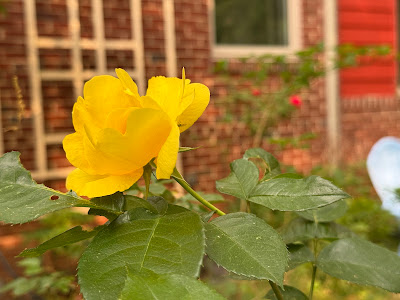 |
| Salad tomatoes, paste tomatoes, cucumbers, mini cucumbers, peppers, cherry tomatoes |
There's a pretty good harvest going in some of the vegetables. I don't pick every day - I plan for when I can spend time cooking or otherwise preserving the harvest. The peppers were coming on strong when I got home from vacation on August 1. The cherry tomatoes were also full steam. The cucumbers were just starting.
 |
| Banana peppers, long green peppers, eggplants, basil, shishito peppers |
I grew two types of main crop tomatoes - early girl, and money maker. I think the ones I'm getting are money maker. They are big salad-sized, not huge slicers. They are still going strong, after a month.
I grew San Marzano roma-types. That plant started turning yellow from the bottom up, but I still got more than one sauce crop out of it.
The bulk of the cherry tomatoes are gumdrop. They are bigger and darker than most cherry tomatoes. The plant in a pot is not doing well, but the one in the ground has become a jungle all by itself. It spread to all four trellis supports, and then up through the roof of the crop cage to cover it! The fruits from the potted one are much smaller. I'm guessing the constrained roots can't support the rampant growth.
I'm growing several varieties of sweet peppers in the green stalk. Mostly I cook with them, though I have some small bells that I have eaten as snacks. I bought a single shisito pepper plant at farmer's market and it has been prolific from June on. I fry the peppers in olive oil whole and just chomp them while holding onto the stem. Tasty!
The little eggplants persist. Every week or so I get a handful and cook them up in the oven or air fryer. I've mostly been eating them as a single dish, but this week I added the cooked eggplant to a ground lamb dish I had made, and it was not entirely unlike moussaka, after I added creme fraiche for creaminess.
 |
| Roasted eggplant and fried shisito peppers |
I have two kinds of cucumbers, pickle sized and full sized. I mostly eat the small ones as finger food, just munching on them. I grated up most of a full sized one to added to yogurt and garlic to make tzatziki sauce. Yum! I'm getting a half dozen little ones a week, which is more than I want to eat. But they are good snacks.
I seem to have failed to take a picture of my single zucchini. I have several very healthy plants, no sign of vine borers or other blights, but there are only male blossoms! I spotted one embryonic female about to bloom, and came back 48 hours later to find it a foot long and past optimal picking. I keep searching under the foliage but see no other fruits happening.
My countertops are full of vegetables ready to be processed. I visited a friend and was amused to find she was the same, with tomatoes finishing ripening and peppers needing to be frozen.
I'm popping cherry tomatoes into bags and right into the freezer, whole and raw. I hear they will still make good sauce, which makes sense. The peppers I either cut and freeze raw, or saute with onions and freeze that way. I'm eating some form of pepper-and-tomato saute, some form of spaghetti, a couple of times a week. The eggplants get eaten right away, and I don't know if its possible to preserve cucumbers, so some of those go to waste.

























